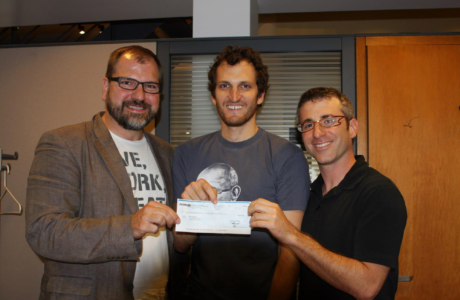The evolutionary journey of self-management at The Moment continues. In this edition of the series, we share the thinking behind our organizational evolution from Teal to Holacracy.
This is the 4th edition in The Moment’s journey to Teal. Read more about The Moment’s journey to Teal here, here, and here.
The evolutionary journey of self-management at The Moment continues. In this edition of the series, I share the thinking behind our organizational evolution from Teal to Holacracy. This transition to an organizational operating system features a shared understanding, a distributed decision-making model, and greater role clarity and accountability–all codified in a constitution—to help us more fully live out our “Tealness.”
New to the concept of Holacracy? You can learn about the organizational model here and watch a panel discussion featuring 4 leaders from self-managing organizations here.
The urgency to disrupt work.
Well before Teal practices were codified and shared with the world, The Moment was committed to “organizing on the edge” and exploring new ways of working. Enabled by our founders’ aspirations and inspired by our varied past work experiences, the early team worked relentlessly to re-invent the approach to work itself by running internal experiments. These experiments had a clear intention, creating a consulting company that was human first.
When Fredrick Laloux’s “Reinventing Organizations” was published it empowered us to create a common language around what we were attempting; we felt a real sense of validation as other organizations around the world also sensed into this urgency to disrupt work. Laloux’s work gave us the confidence and fuel to pursue this next organization design challenge and to share our story with other aspiring practitioners.
Self-management: from intention to reality.
The Moment was drawn to creating a structure where everyone in the organization felt empowered to pursue their purpose. While the principles were in place and the inspiration from “Teal” was clear, the transition beyond founders as decision-makers was greatly disorienting.
The power dynamics—visible and invisible—were still in play and having a group of well-intentioned and caring team members left people feeling “stuck” instead of liberated. Although we had a shared understanding of the Teal concepts and an elaborate set of tools and rituals in place, something was still missing. We were “green” more than ever (in reference to Laloux’s paradigm) as emotions were still the prevailing element when making or avoiding decisions.
We needed a way to liberate the business from the great degree of emotions that were driving our tight-knit team.
The good news is that we moved past this by creating a safe space and an environment that thrived on transparency. In this new space, we were able to have difficult and honest conversations. Most of them pointed towards finding clarity and giving ourselves a sufficient yet dynamic structure to distribute tasks and responsibilities and with that, decision-making powers and accountabilities. We clearly needed to change how we governed ourselves. We needed a way to liberate the business from the great degree of emotions that were driving our tight-knit team.
Hola Holacracy!
The Moment has a track record of working with organizations on behaviour change. We know it’s hard work that requires a solid foundation and intentional strategies to break established patterns and mindsets while also introducing new ones.
So, when it came to layering an operating system onto our Teal organization, it had to align with our culture and work principles while helping us move closer to achieving our purpose. The system had to be structured enough to keep us in new governance patterns, flexible enough not to limit our creativity, and most importantly it needed to be introduced mindfully to transition the organization and the team in a way that felt safe and empowering.
Anyone who has worked with us knows that we are thoughtful and thorough. This particular challenge—transitioning to holacracy—was high-stakes.
We gravitated towards Holacracy for a number of reasons. First, Holacracy is a derivative of other systems we were already familiar with—like the Agile software development process—that are intended to increase adaptability within workplaces. The big difference is that Holacracy is more radical. Secondly, we knew that if we continued to operate on the Teal model, we would never get to a structure that would support the business outcomes to drive toward our purpose. We knew something had to change.
The philosophy behind Holacracy—that power needs to be distributed throughout the network—made total sense to us, particularly for the goals we had in mind. That said, in our community there are a lot of mixed feelings about Holacracy. We decided to test it.
We invited Joost Schouten to come in and give us a first-hand experience in how governance works. It felt unnatural compared to the way our organization was running at the time. That experience triggered as much concern as excitement. So we paused.
My colleague Karen Oikonen and I embarked on a research journey. We focused on collecting stories from our colleagues including the founders through semi-structured interviews. We also conducted desk research to pull together a rigorous body of information. We synthesized our learnings and gave the founders our recommendations.
We were proud to drink our own champagne when the opportunity arose—applying the same innovation process we use with clients on ourselves. It wasn’t just about research or recommendations; it was about building a level of maturity to accomplish such a difficult task, which required a high level of transparency, physiological safety, and trust.
Why Holacracy?
The research we presented consisted of four main sections: The Founders’ Views, The Team’s Experience, Design Principles, and Why Holacracy?
As you may have guessed by now, we recommended Holacracy as a governance model because its rule set, by design, shields decision-making from the emotions of individuals and their relationships (the system differentiates “role” from “soul.”)
The Constitution, in its original form, makes sure that the same rule set applies for everyone in the organization, which enables full distribution of power and decentralization of decision-making.
An important distinction to make here is that we didn’t need Holacracy to replace managers, as it is typically introduced to do–we didn’t have any managers to begin with. We always took pride in the fact that we were unlike a conventional organization with a power hierarchy. With “Teal” we had forgone seniority in job titles. We were engaging with each other as equals, invited our teammates to take ownership of their own career development, and even created structures to allow for self-set compensation.
We were set to operate more responsively and dynamically. However, we still had one major blocker holding us back: our tendency to seek consensus, which led us again and again to feel stuck, even trapped in the “Green” state.
Our hope was for Holacracy was to help us achieve the following:
1. Provide a clear and transparent map for how The Moment works as a business, which was crucial as we were growing.
2. Clearly define boundaries for all roles, ensuring clear expectations and limitations, and identifying levels of decision-making to bring clarity to who have the right to make which decisions.
3. Acknowledge that we were not in fact a flat organization, and provide a structure to liberate us from consensus.
4. Support our team to shift from consensus to a culture of accountability.
5. Enable a strong bias-to-action through Holacracy’s mechanisms of tensions, objections, and governance.
All the signs pointed to the fact that Holacracy would deliver on these elements—as long as we continued, through our Teal principles and practices, to look after our people. The Holacracy operating system doesn’t offer any solution to the social system within the organization, and we were okay with that.
From source to boss to purpose.
In a conventional power hierarchy, individuals need to use power, relationships, and emotions to convince, to negotiate, and to advance their agendas. They use power to prioritize their plans and needs over others. This isn’t necessary in Holacracy, because it isn’t necessary in self-organization models. The entire system has clarity and transparency about where each authority lies, which can be changed and adapted at any moment in time within the boundaries of the purpose.
Every organization starts with an idea. The human that takes the idea from conception to realization—usually the founder—is the source. The source holds an immense power that needs to be acknowledged. In traditional contexts, the founder is the boss and typically sits on the top of the hierarchy of the organization.
In a self-managing organization, identifying the source and channeling its authority into the purpose as part of the transition is probably the most important step. Although Holacracy doesn’t necessarily speak about the source, skipping the ritual of identifying and transitioning is a misstep that could put the shift at risk.
An organizational purpose is not about economic exchanges. It reflects something more aspirational. It explains how the people involved with an organization are making a difference, gives them a sense of meaning, and draws their support.
Humans are far more complex than we can imagine. It is not enough to shift the organization to a new operating system—we need to shift the mindsets and behaviours within and around the system.
In Holacracy, purpose is the boss. In a rule system that allows you to operate without rulers, purpose instills clear structure, clear boundaries, and a sense of direction that supports decision-making while anchoring people in a sense of lucidity. By emphasizing purpose, Holacracy encourages us to think how individual actions in roles contribute to the purpose of our circles, and ultimately the holistic purpose of the organization. It is a north star that is fundamental to continuously steer the business in the same direction as multiple captains are on board.
As part of The Moment’s transition to holacracy, the founders worked collaboratively to craft a purpose statement that captured their vision as source and passed the torch by setting the purpose of the general circle. We also evolved to a new lexicon: “The founders are dead, long live the shareholders!”
The shift and then the actual Power Shift.
Humans are far more complex than we can imagine. It is not enough to shift the organization to a new operating system—we need to shift the mindsets and behaviours within and around the system.
Holacracy is like any well-designed game: once you learn the rules you can apply them mechanically, outsmart the game, or simply choose not to play. Eventually the old drivers and human instincts kick in, and you find yourself in a system that favours those who manage to cloak their powers in unrecognizable ways.
How do you keep power in check?
Self-awareness and feedback are key—it is a journey of continuous learning and self-discovery. It requires letting go but also leaning in. We often talk about letting go of the “predict and control” paradigm and embracing “sense and respond.” This requires a departure from a top-down dependency system to one of autonomy; a departure from reactive a mindset to a mindful one.
Christiane Seuhs-Schoeller speaks about the shift from the “power over” to the “power with,” which requires the power holder to cede their power into the system and everyone stepping up to share the power. Peter Aprile—who’s organization also transitioned to Holacracy—says that power isn’t a “zero-sum game” and when leaders distribute power to others everyone becomes more powerful.
This shift can be scary for all parties involved. “Losing” power can be as difficult as “gaining” power and responsibility.
Does the organization provide the support needed for this transition?
The Moment went through a 2-step process, with the first iteration still reflecting aspects of the past. With the shareholders filling most Lead Links roles, the shift was not fully realized. The concept of Lead Link, if not well understood, could come across as a safety measure to still “manage” the circles while potentially encouraging old behaviours and mindsets.
It took us some time to build confidence in what we created to truly embrace the shift. Holacracy coach Sally McCutchion and I collaborated closely to inject an outsider perspective and help accelerate our learning curve. This transition starts within both the mind of the power holder and the power taker. It requires us to overcome our fear while strengthening a muscle that acts against our impulses until new norms are established.
In our second iteration of the organization (and the zillion ones that followed and continue to emerge), things are looking different and much more authentic. Holacracy is the way we run the organization and our social system in our continuous journey to develop.
Working with leaders and practitioners across different industries and configurations over the last few years has taught us that there’s no silver bullet or one-size-fits-all blueprint when it comes to creating organization design that works for everyone.
Holacracy has been one way for us to experiment with new systems of organizing and working that challenge us to continue on a path of development while delivering on our purpose.
Holacracy has been one way for us to experiment with new systems of organizing and working that challenge us to continue on a path of development while delivering on our purpose. It helps us to overcome our fears which is integral to the personal and organizational journey into self-management.
What does the team think about holacracy?
You don’t have to take my word for it. Here are a couple of direct quotes from team members who participated in our assessment after about 1.5 years of our Holacracy implementation. When asked to reflect on their experience, our Momenteers said:
“I feel a LOT of confidence in the organization with each Momenteer accountable, I feel empowered in many ways to dive in and do it and have noticed myself growing as I just DO things instead of seeking approval or support (when it’s not actually needed.)”
“It’s an interesting mind shift, and through the autonomy and responsibility that Holacracy provides, I find that people really lean into their responsibilities here, we are not “employees,” but are much more invested in and work harder and care more about what we do.”
I’ll be looking forward to sharing more first-hand stories as The Moment transitions to a fully employee-owned organization.









